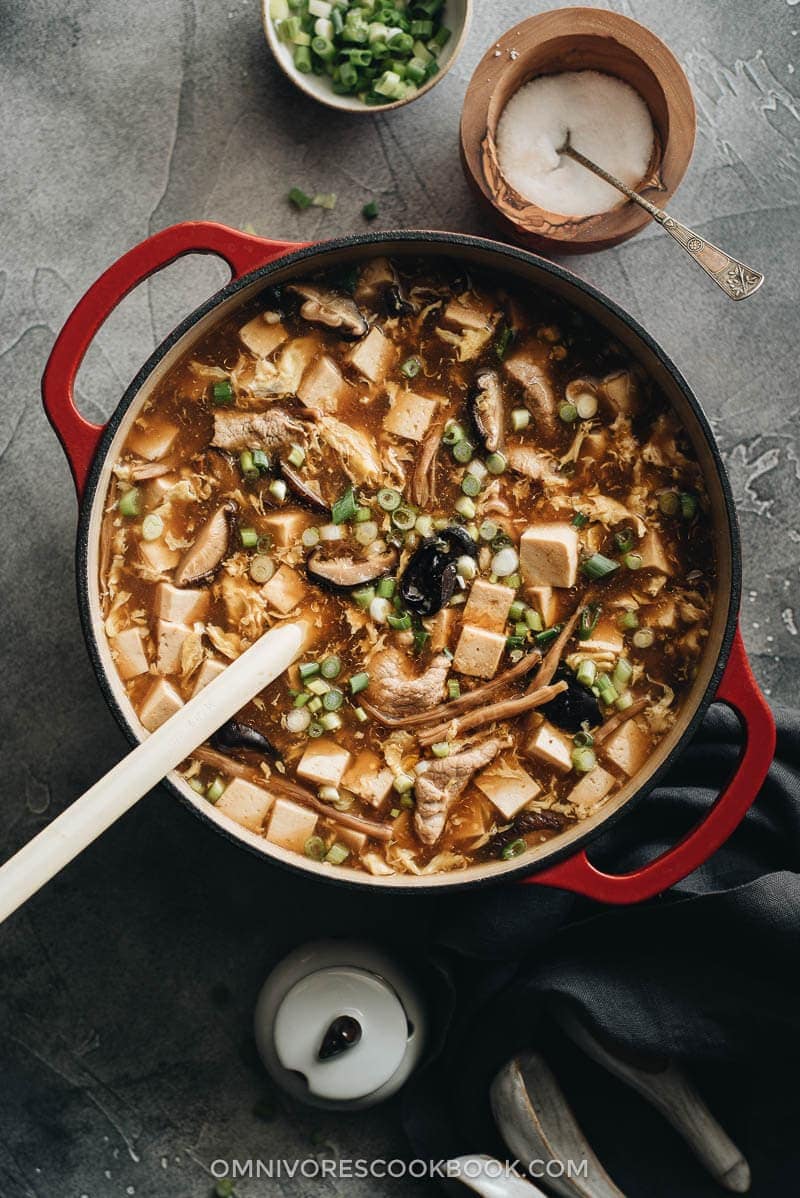
Hot and sour soup is such a popular dish takeout dish, along with egg drop soup and wonton soup. It’s one of those things that we almost always order when eating in a restaurant. The soup is loaded with so many goodies that I totally wouldn’t mind serving it as a main dish for a light dinner.
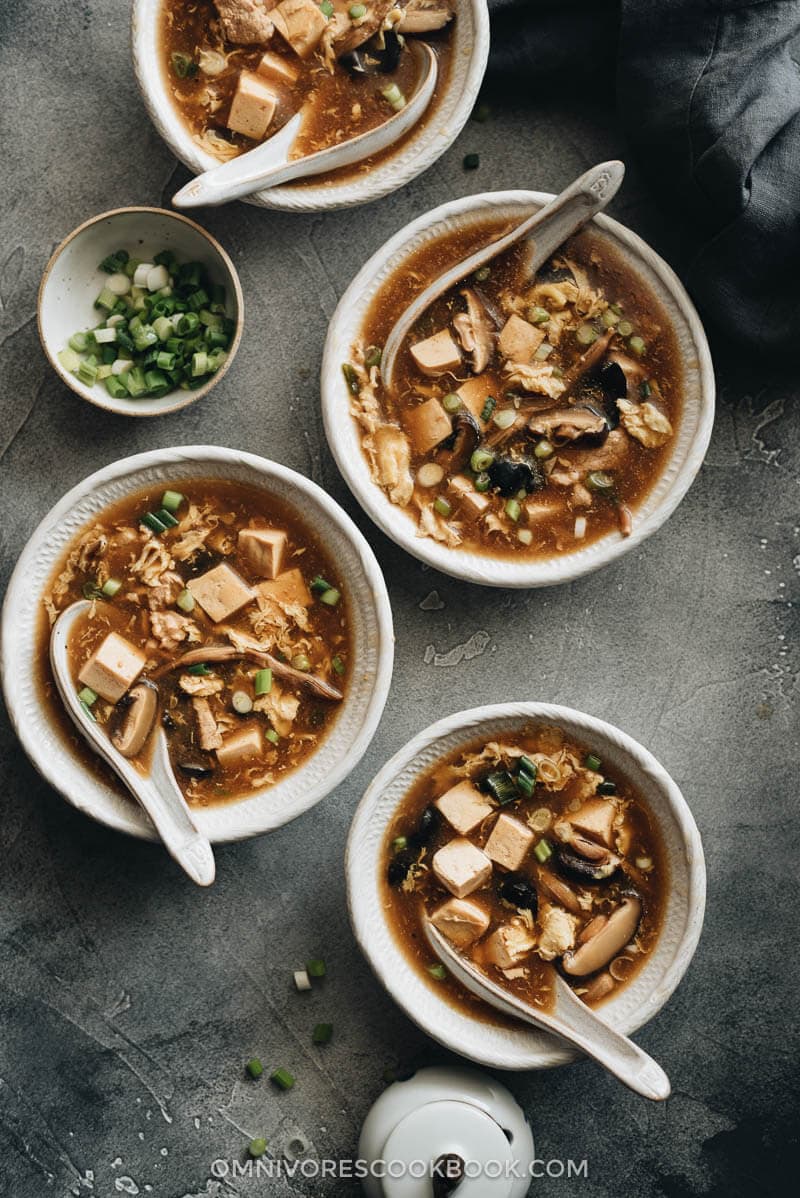
The soup base
Did you know that hot and sour soup is actually super easy to make?
Yes, the recipe below might look a bit long, because I wanted to create a proper restaurant-style hot and sour soup for you. But in fact, the soup base requires only a few ingredients:
- Chinkiang vinegar
- White pepper powder
- Water mixed with cornstarch (to thicken the soup)
That’s it!
The sourness of the soup comes from the Chinkiang vinegar. And the spiciness comes from the white pepper powder. No peppers or chili oil required!
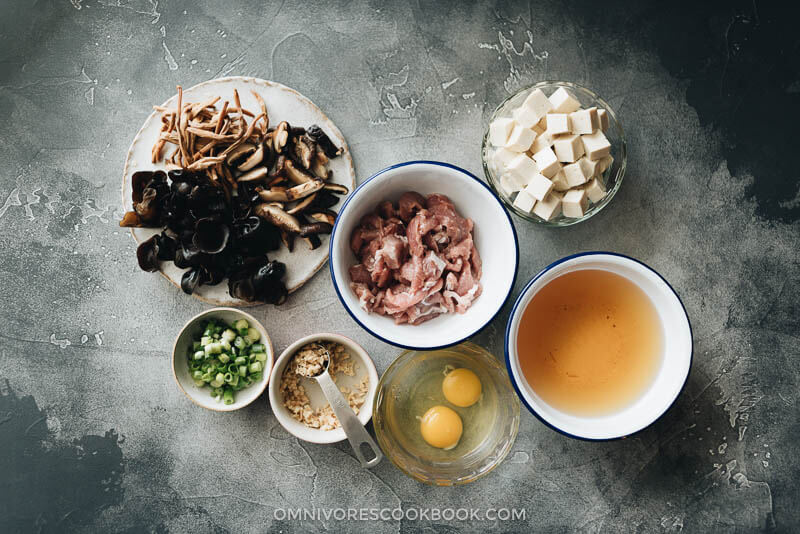
A word about the dried ingredients
My recipe uses some dried ingredients that might require a trip to an Asian market or a purchase on Amazon. But if you don’t want to make the extra effort, you can totally skip these ingredients. I will explain why.
I previously discussed how to use Chinese dried veggies to create a superior flavor in another recipe – Buddha’s Delight, a Jai (Buddhist vegetarian) dish. The logic is the same here. The foundation of the broth consists of dried lily flowers and dried shiitake mushrooms. They both have a very concentrated smoky, earthy, and woody aroma. Once you rehydrate them, the rehydrating water will turn a dark brown color as it becomes infused with the great flavor. Do not throw this water away. It is the best vegan broth and you should use it to make the soup base.
The other dry ingredient is wood ear mushrooms. It is a mildly flavored fungus that adds a crunchy texture to the dish.
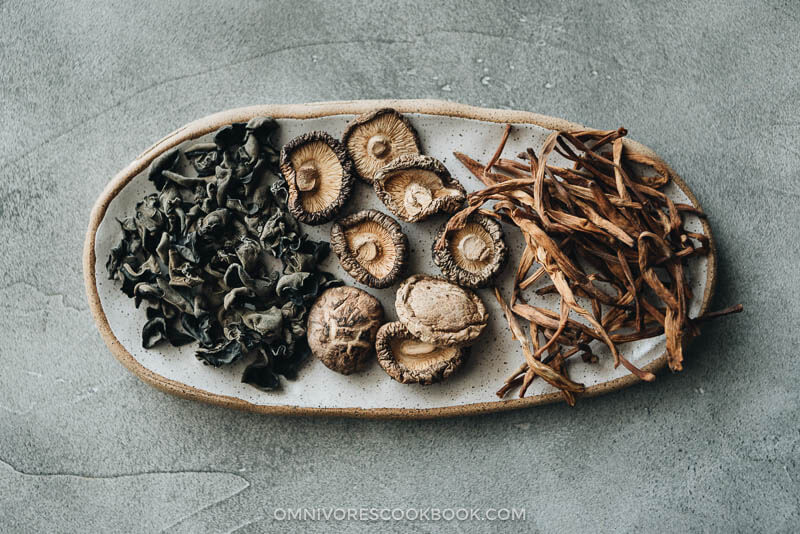
Chinese families always have these ingredients on hand because they allow a cheaper and healthier way to create a flavorful authentic Chinese soup recipes. If you use these ingredients, your soup will turn out more like the Chinese restaurant version.
However, if you do not have these ingredients, simply skip them and use chicken stock or vegetable stock instead of water to make your soup.

Cooking notes
1. How to convert this recipe to vegetarian
Simply skip the “marinate” part of the recipe, including the pork and the few ingredients for the marinade. Many Chinese recipes use a small amount of meat to add volume and texture to the dish. Skipping the meat won’t affect the flavor of the soup.
2. Other vegetables and proteins to use in this recipe
There are so many more ingredients that work well in this dish.
For example, some of my favorite vegetables include – tomatoes, napa cabbage, bamboo shoots, mushrooms, and bok choy.
You can also use a different type of protein to replace the pork. For example, chicken or shrimp would work great. You can even throw in a few slices of cooked sausage or ham to make the cooking faster.
3. Workflow
Add vinegar and white pepper at the end of cooking – this is very important. Otherwise the pureness of the vinegar will disappear as the vinegar evaporates and the white pepper will release a bitter taste if heated for too long.
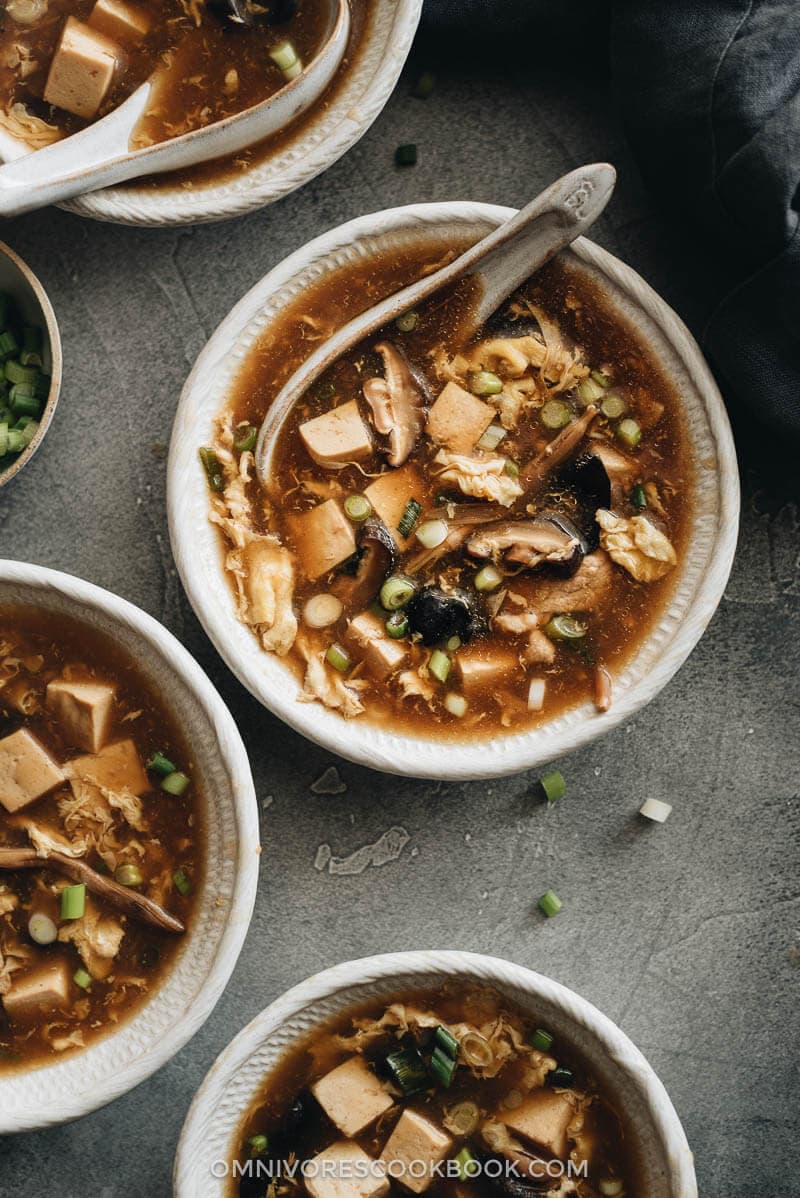
More Chinese takeout recipes
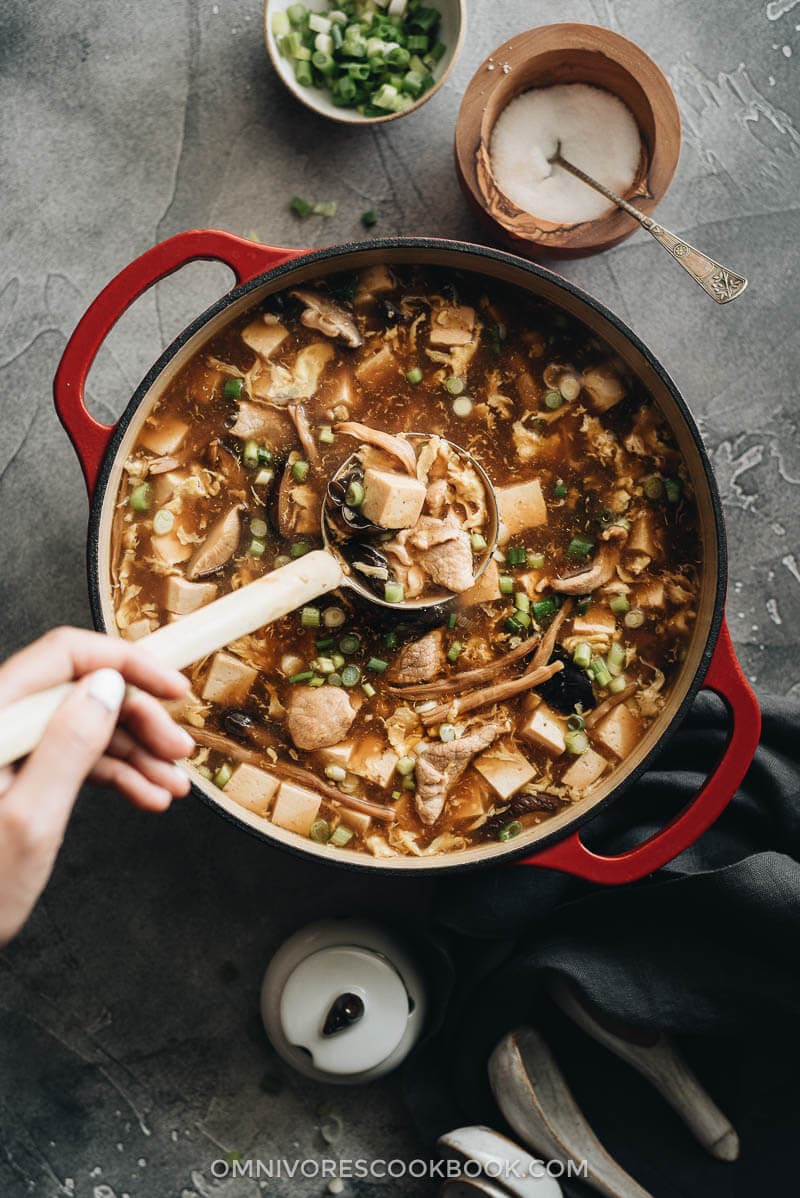
If you give this recipe a try, let us know! Leave a comment, rate it (once you’ve tried it), and take a picture and tag it @omnivorescookbook on Instagram! I’d love to see what you come up with.
Chinese Cooking Made Easy
Are you new to this website? This free email series is a great place to start. I’ll walk you through a few of my most popular recipes and show you how and why they work. You’ll quickly start to cook better Chinese food in your own kitchen.
Watch video
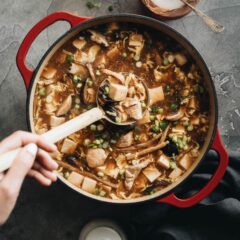
Hot and Sour Soup (酸辣汤)
Ingredients
(Optional) Rehydrate (*Footnote 1)
- 1/3 cup dried shiitake mushrooms
- 1/4 cup dried woodear mushrooms
- 1/4 cup dried lily flowers
Optional Marinate (*Footnote 2)
- 1/2 lb pork loin (or chicken breast) , cut into thin strips
- 1/2 tablespoon Shaoxing wine (or dry sherry)
- 1/4 teaspoon salt
- 1/2 tablespoon cornstarch
Soup
- 2 teaspoons minced ginger
- 2 green onions , chopped
- 2 tablespoons Chinkiang vinegar
- 1 teaspoon white pepper powder (or 1/2 teaspoon white pepper powder for a less spicy dish)
- 6 cups water (or chicken stock) (*Footnote 3)
- 1/2 block firm tofu (8 oz / 227 g) , cubed
- 1 tablespoon light soy sauce (or soy sauce)
- 3 tablespoons cornstarch
- 1 teaspoon salt or to taste
- 2 eggs , beaten
- 1 teaspoon sesame oil
Instructions
- Gently rinse dried shiitake mushrooms, dried wood ear mushrooms, and lily flowers with tap water. Soak each of them with 1.5 to 2 cups warm water in three big bowls. Rehydrate for 30 minutes to 1 hour, until tender. Slice mushrooms into strips. Snip off the tough ends of lily flowers and discard. Remove tough ends of wood ear mushrooms, then chop into bite-sized pieces. Reserve the marinating water from lily flower and shiitake mushrooms, 2 cups in total
- Combine pork, Shaoxing wine, salt and cornstarch in a bowl. Mix well by hand. Marinate for 10 – 15 minutes.
- Add Chinkiang vinegar and white pepper into a small bowl. Mix well until the white pepper is completely dissolved.
- Add water or chicken stock, ginger, and green onion into a pot and heat over medium-high heat. If you reserved the marinating liquid from step one, you can add it plus 4 cups water or chicken stock.
- Add rehydrated wood ear mushrooms, shiitake mushrooms, lily flowers, and tofu to the pot. Cook until bringing to a simmer. Add soy sauce and turn to medium-low heat.
- Mix the cornstarch with 1/4 cup of water in a bowl until cornstarch is fully dissolved. Slowly swirl the cornstarch slurry into the soup. Stir to thicken the soup.
- Add the pork from step one into the soup, stirring several times to prevent the pork strips from sticking together. Add the salt. Slowly swirl in the beaten egg and stir well. The egg should be scattered and not clotted.
- Remove the pot from stove. Add the vinegar and pepper mixture and stir to mix well.
- Garnish with cilantro and drizzle with sesame oil. Give it a final stir. Taste the soup and add more salt if needed.
- Serve hot.
Notes
- If you do not have these dry ingredients, you can use half a pound of fresh mushrooms instead. Then use chicken stock instead of water to make the soup.
- Skip the meat if you want to create a vegetarian dish.
- Use chicken stock or vegetable stock instead of water if you are not using the dry ingredients (shiitake mushrooms, lily flowers, and wood ear mushrooms) in this recipe.
Nutrition

Did you make this recipe?
I’d love to hear how it turned out for you! Please take a moment to leave a 5-star rating ⭐️ and share your thoughts in the comments further down the page. It really helps others discover the recipe too.
The recipe was originally published on April 9, 2014 and updated on June 5, 2018.

NMR
Great recipe!
Question though, some restaurants have a darker/browner hot and sour soup—my dad describes it as being more like “tea”–I’ve never thought that, but I do think it’s delicious—it’s definitely less vinegary. Assuming you have an idea of what I’m talking about, do you know how I could achieve that? If you’re ever in Massachusetts, China Gourmet in Greenfield has the hot and sour soup I want to recreate.
Thanks!
malinda
This is a rich, easy to make, delicious soup! I’d not known about Dried Lily Flowers and they were a nice addition. This is the BEST web site for Chinese recipes. I’ve looked for years to find one and none meet the degree of authenticity as this one! Thank you